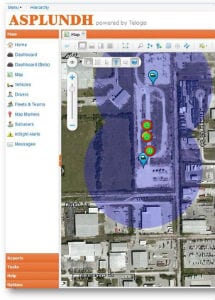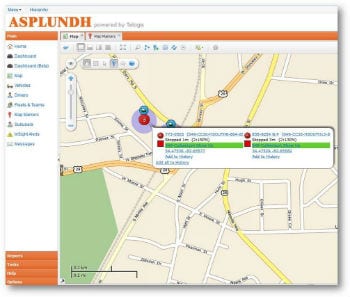Asplundh Tree Expert Co., a nationwide clearance-services company, manages over 16,000 fleet trucks but has no permanent garages — relying entirely on overnight parking lots near job sites. So how does it keep track of its nationwide fleet and ensure trucks are rolling efficiently to the nearest sites? It depends on a set of geofencing tools and apps — an emerging GPS-based technology with an array of business and consumer applications. (Heads up: Apple recently filed a geofencing patent for disabling texting in theaters.)
In a nutshell, geofencing technology uses GPS-enabled mobile devices to set up virtual boundaries, or “fences,” around designated areas. For Asplundh, that enables live tracking of fleet vehicles when they enter a physical job site or other designated or secure areas. When a fleet truck or mobile worker crosses one of these geofences, the time and location is logged and sent as an email or pop-up alert to recipients of choice.
 “When the vehicles move out in the morning and return at the end of the day, we know the approximate start and end times of the work day,” says James Orr, an Asplundh vice president.
“When the vehicles move out in the morning and return at the end of the day, we know the approximate start and end times of the work day,” says James Orr, an Asplundh vice president.
Setting Virtual Boundaries
Asplundh uses an automated vehicle location (AVL) tracking system from Telogis that collects and transmits location information over wireless networks from the vehicle to the AVL platform. CalAmp manufactures the actual devices in the trucks. They can offer features like message logs, GPS support, and an accelerometer for motion sensing, driver behavior, impact detection, and hard braking.
Orr says the technology ultimately is what you make of it. His company simply uses it to keep watch over company property and to analyze what each job site requires in terms of manpower and time required. Other companies use it to replace traditional clock-in systems and provide mangers information about the amount of time spent on a given job. Geofencing can also offer data for route-efficiency comparisons.
 Indeed, companies like J.B. Hunt Transport Services and Schneider National Inc. Truckload and Transportation Services have also started incorporating geofencing into daily activities. More specifically, J.B. Hunt uses it to confine trucks to a certain area and receive alerts when doors are opened or the trailer moves outside the perimeter while Schneider uses geofencing in its trailer-tracking system to record arrival and departure times at shipping and receiving locations.
Indeed, companies like J.B. Hunt Transport Services and Schneider National Inc. Truckload and Transportation Services have also started incorporating geofencing into daily activities. More specifically, J.B. Hunt uses it to confine trucks to a certain area and receive alerts when doors are opened or the trailer moves outside the perimeter while Schneider uses geofencing in its trailer-tracking system to record arrival and departure times at shipping and receiving locations.
SEE ALSO: Where Are Your Field Workers? Study Says Most Companies Don’t Know.


Share this: